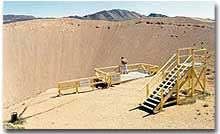The Manhattan Project

The Manhattan Project was the codename given to the top-secret project that they US government organized during World War 2. The intent of the project was to build the world’s first Atomic bomb.
Shortly before, nuclear fission had been discovered, and with that discovery, the possibility for such a weapon opened up. Fear grew that the Axis powers were attempting to harness nuclear power and build an atomic bomb. This sparked many scientists, including Albert Einstein (who had earlier fled Germany because of the Nazi Regime) and Enrico Fermi (who had escaped Fascist Italy) to encourage the US government to study the potential for an atomic weapon.
Research started slowly; secrecy was paramount, as the Japanese and Germans could not be allowed to discover the project. Initially, only three campuses were involved in the research: Colombia University, the University of Chicago, and University of California at Berkeley. However, after Fermi, working with a group of other scientists, produced the first controlled nuclear chain reaction, funding was drastically increased, and the research began to progress very quickly.
On July 16th, 1945 the world’s first atomic bomb (called “Fat boy”) was detonated at the Trinity site, near Alamogordo New Mexico. The scientists were not prepared for the result. A blinding flash lit the sky, visible for 200 miles, followed by a 40,000 foot mushroom cloud. A crater a half mile in diameter was left around the site of the bomb, and the sand near it had metamorphosed into glass.
The success of the first bomb inspired scientists to build two more; “Little boy” and “Fat Man” which were used in the bombings of Hiroshima and Nagasaki in 1945.
The Manhattan Project was a very important part of US history. A small group of scientists secretly built the world’s most dangerous weapon. Knowing little about the true effects that the bombs they built would have on the world; they dropped two in Japan, killing over 100,000 civilians. The bombs were responsible for the end of World War 2, which might otherwise have dragged on many more months or years in the Pacific. Their effect did not end there, however. Thousands of people not killed directly by the blast were exposed to radiation that poisoned them, sometimes killing them quickly, other times slowly, and often being passed down to their children as horrible birth defects.
The bombs also introduced to the world a new kind of weapon with terrible powers of destruction. While the bombs dropped in Hiroshima and Nagasaki are the only two atomic bombs ever to have been used in wartime, the technology for them has not been lost, and has thus created a permanent threat of the outbreak of a nuclear war.
Shortly before, nuclear fission had been discovered, and with that discovery, the possibility for such a weapon opened up. Fear grew that the Axis powers were attempting to harness nuclear power and build an atomic bomb. This sparked many scientists, including Albert Einstein (who had earlier fled Germany because of the Nazi Regime) and Enrico Fermi (who had escaped Fascist Italy) to encourage the US government to study the potential for an atomic weapon.
Research started slowly; secrecy was paramount, as the Japanese and Germans could not be allowed to discover the project. Initially, only three campuses were involved in the research: Colombia University, the University of Chicago, and University of California at Berkeley. However, after Fermi, working with a group of other scientists, produced the first controlled nuclear chain reaction, funding was drastically increased, and the research began to progress very quickly.
On July 16th, 1945 the world’s first atomic bomb (called “Fat boy”) was detonated at the Trinity site, near Alamogordo New Mexico. The scientists were not prepared for the result. A blinding flash lit the sky, visible for 200 miles, followed by a 40,000 foot mushroom cloud. A crater a half mile in diameter was left around the site of the bomb, and the sand near it had metamorphosed into glass.
The success of the first bomb inspired scientists to build two more; “Little boy” and “Fat Man” which were used in the bombings of Hiroshima and Nagasaki in 1945.
The Manhattan Project was a very important part of US history. A small group of scientists secretly built the world’s most dangerous weapon. Knowing little about the true effects that the bombs they built would have on the world; they dropped two in Japan, killing over 100,000 civilians. The bombs were responsible for the end of World War 2, which might otherwise have dragged on many more months or years in the Pacific. Their effect did not end there, however. Thousands of people not killed directly by the blast were exposed to radiation that poisoned them, sometimes killing them quickly, other times slowly, and often being passed down to their children as horrible birth defects.
The bombs also introduced to the world a new kind of weapon with terrible powers of destruction. While the bombs dropped in Hiroshima and Nagasaki are the only two atomic bombs ever to have been used in wartime, the technology for them has not been lost, and has thus created a permanent threat of the outbreak of a nuclear war.
